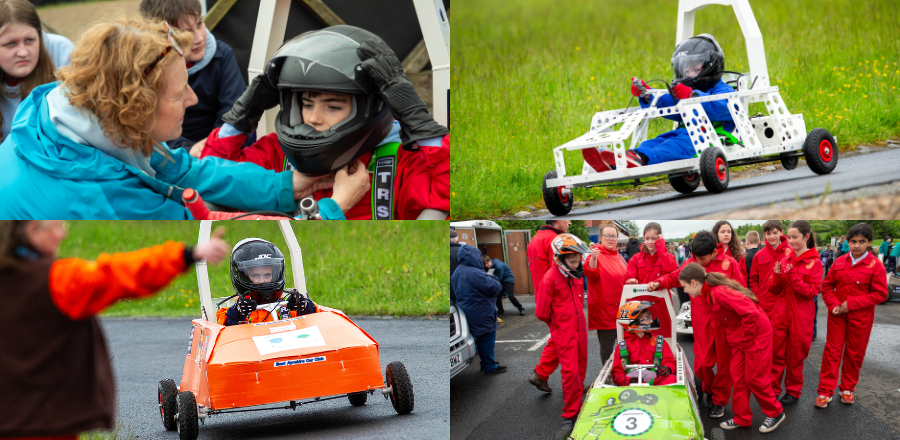Glasgow Caledonian helps schoolchildren race into STEM with electric “goblin cars”

In an exciting STEM education initiative, Glasgow Caledonian University has partnered with the Royal Navy, Royal Society, and nine local primary schools to introduce young students to the world of electric-car engineering.
More than 700 children aged 8-12 have designed, built and now raced their very own “goblin cars” − a class of electric vehicles from the Greenpower Education Trust. Each primary school received £3,000 in Royal Society grants to cover materials and transportation costs.
The initiative culminated in two major events this week. On May 29, the primary school teams raced their goblin cars at Kames racetrack in East Ayrshire, with transportation provided by 43 Commando lorries from the local Royal Marines base HMNB Clyde.
Over the course of nine months, the children participated in in-school workshops facilitated by engineering students from Glasgow Caledonian University and the Royal Navy, with support from carers and teachers. Their goal was to construct goblin cars capable of reaching speeds up to 20mph. Ultimately, they raced their creations against each other in a time trial event at Kames, organised by the University with help from the Jim Clark Trust and Motorsport UK.
Following the race, Glasgow Caledonian’s city campus hosted a finale event on May 30, featuring presentations, displays and lab tours for all participating children, including those with additional needs. The children’s goblin cars were again transported by the Royal Marines for a public display.
“The idea was to get children hands-on with the engineering of an electric car and open their eyes to STEM careers,” said project lead Professor Patricia Munoz de Escalona from the University’s Mechanical Engineering Department. “They’ve learned about aerodynamics, composites, design and car manufacturing along the way.”
In addition to helping the schoolchildren to build the goblin cars, Glasgow Caledonian game-design students developed a racing video game featuring the project car designs to further engage the schools and expand their interest in STEM.
“This was a great opportunity for our own students too, to develop global skills collaborating across academia, industry and the community,” added Professor Munoz de Escalona. “We’re grateful to the Royal Navy personnel who supported the workshops and events.
“By sparking children’s passion for STEM through fun, hands-on learning, Glasgow Caledonian aims to inspire the next generation of engineers and innovators.”
David Rigmand, Head Teacher at Wallace Primary School, Renfrewshire, said: “We’ve had eight schools involved across Renfrewshire. It’s been great to see the children involved develop skills for life and work, and to make a connection with a university and see the opportunities out there in engineering.
“They have also learned that engineering is multifaceted and hands-on, and getting to do this in collaboration with other schools and Glasgow Caledonian University has been an exciting experience for them.”
Emma Paterson, Primary 7 pupil at Wallace, said: “I loved that we got to build a car and learned how each part works and why it is needed. It was brilliant that we then got to drive the car at a race track and visit Glasgow Caledonian University, to see how they do things every day and how we could go there and do the same in the future.”
Linda Candlish, Deputy Head Teacher at Colgrain Primary, Helensburgh, said: “Having the Glasgow Caledonian University students and Royal Navy come in and work with our pupils has not only aided their project-based learning and meta skills, but has also inspired the pupils to learn transferable skills and gain an interest in what they could go on to learn at university.
“One of the major perks of this project is inclusivity. There are not many projects where pupils can harness all of their skills. We have children with additional support needs and who are anxious about their learning, and this hands-on project has brought them right out of their shell.”
Primary 7 pupil at Colgrain, Floraidh Walker, said: “I learned how the inside of a car works and how to put one together. I learned team work and it was really good fun. I would like to go to university to explore mechanics further.”
